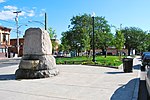Washington Park Historic District (Albany, New York)

Washington Park in Albany, New York is the city's premier park and the site of many festivals and gatherings. As public property it dates back to the city charter in 1686, and has seen many uses including that of gunpowder storage, square/parade grounds, and cemetery. The park is often mistaken as being designed by Frederick Law Olmsted, as it incorporate many of the philosophical ideals used by Olmsted when he designed Central Park in Manhattan. The park is about 81 acres (33 ha) in size with the 5.2-acre (2.1 ha) Washington Park Lake, a roughly 1,600-foot-long (490 m) and 140-foot-wide (43 m) lake, in the southwestern corner.Not only is the park historic, but so is the mostly residential surrounding neighborhood. Many architectural works line the streets facing the park, designed by some of the most famous architects of the late 19th century, including Henry Hobson Richardson. At least two governors of New York lived in buildings facing Washington Park outside of their term in office. Due to the historical and architectural significance of the park and neighborhood both were included in 1972 as the Washington Park Historic District; and in 1998 the park was named one of the nation's 100 most important parks by the American Association of Architects. In 2008 Boston-based composer Peter Child wrote an orchestral piece inspired by the park, entitled Washington Park.
Excerpt from the Wikipedia article Washington Park Historic District (Albany, New York) (License: CC BY-SA 3.0, Authors, Images).Washington Park Historic District (Albany, New York)
Washington Park Road, City of Albany
Geographical coordinates (GPS) Address Nearby Places Show on map
Geographical coordinates (GPS)
| Latitude | Longitude |
|---|---|
| N 42.656944444444 ° | E -73.771666666667 ° |
Address
Washington Park Road
Washington Park Road
12210 City of Albany
New York, United States
Open on Google Maps









